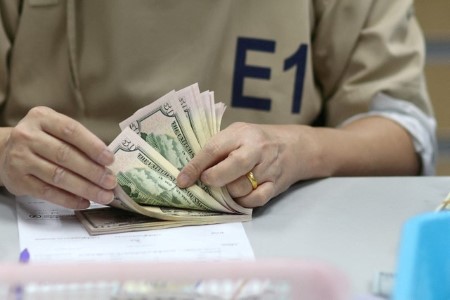




Quarterly Economic Growth Release: More BSP cuts to come
 DOWNLOAD
DOWNLOAD

Monthly Economic Update: Fed catches up
 DOWNLOAD
DOWNLOAD

Inflation Update: Steady and mellow
 DOWNLOAD
DOWNLOAD


Dollar eases after US retail sales miss expectations in May

NEW YORK – The dollar eased against the euro on Tuesday after retail sales data indicated signs of exhaustion among US consumers, boosting the case for Federal Reserve rate cuts later this year.
US retail sales increased less than expected in May as lower prices for gasoline and motor vehicles weighed on receipts at service stations and auto dealerships.
The trend in sales growth has been slowing as higher prices and interest rates force households to prioritize essentials and cut back on discretionary spending.
“It may have come later than initially expected, but the tight financial conditions engineered by the Fed finally appear to be straining household budgets this year,” said Stuart Cole, chief economist at Equiti Capital.
“But a softer pace of consumption may actually be welcomed by the Fed, as it makes the task of returning CPI back to target that much easier, especially given the key role domestic consumption plays in driving US economic activity,” Cole said.
The euro was 0.02% higher at USD 1.073625. The common currency slipped as low as USD 1.071 earlier in the session.
Against a basket of currencies, the dollar was about flat at 105.30.
“The softer-than-expected retail sales report increases the likelihood that the Fed starts to cut interest rates in a few months,” Bill Adams, chief economist at Comerica Bank, said in a note.
Fed Funds futures implied a 67% probability of at least one rate cut by the September Fed meeting, up from 63% a day ago.
Philadelphia Fed President Patrick Harker said on Monday that he backs only one interest rate cut this year, but left the door open to changing his view depending on incoming data.
A long list of Fed officials take to the podium at various venues later in the day, including the Boston Fed’s Susan Collins and the Richmond Fed’s Thomas Barkin.
Last week, mild US inflation readings contrasted with an overall hawkish stance by Fed officials, who trimmed their previous median projection for three quarter-point rate cuts this year to one.
Last week’s rally in the dollar was mostly driven by a sharp euro selloff after French President Emmanuel Macron called a shock snap election in response to his ruling centrist party’s trouncing by Marine Le Pen’s eurosceptic National Rally in the European Parliament elections.
The euro has stabilized since.
“Over the weekend, France’s Le Pen said that she would be ready to work with President Macron and would not seek him out,” said Mohit Kumar, chief economist for Europe at Jefferies.
“A portion of the recent risk-off moves have been driven by fears of ‘Frexit’ and euro area breakup,” he said. “Those fears are overblown.”
The dollar was little changed against the yen at 157.81 yen, holding below Friday’s six-week high of 158.26.
Sterling was flat on the day at USD 1.2705 as investors waited for inflation figures on Wednesday and the Bank of England’s interest rate decision the day after that.
Meanwhile, the Aussie dollar was 0.6% higher after the Reserve Bank of Australia held rates steady on Tuesday. “The RBA’s position was well-telegraphed: they’re in wait-and-see mode until they get more inflation data,” said NAB’s Catril.
In cryptocurrencies, bitcoin fell about 3% to USD 64,475, a one-month low.
(Reporting by Saqib Iqbal Ahmed; Additional reporting by Harry Robertson in London and Kevin Buckland in Tokyo; Editing by Christina Fincher, Bernadette Baum, and Sandra Maler)
This article originally appeared on reuters.com





 By Reuters
By Reuters